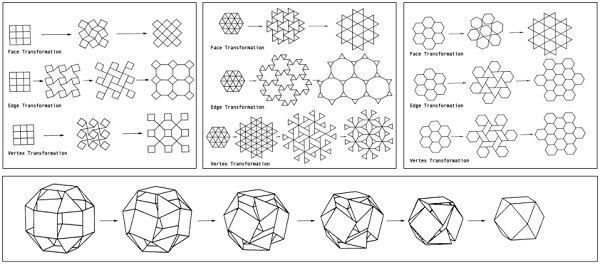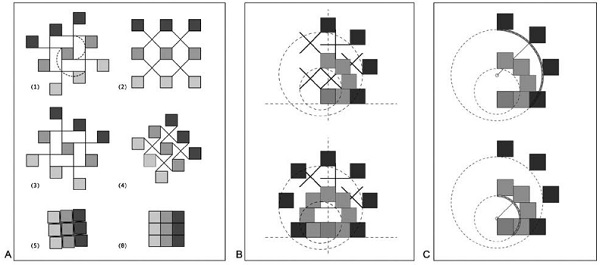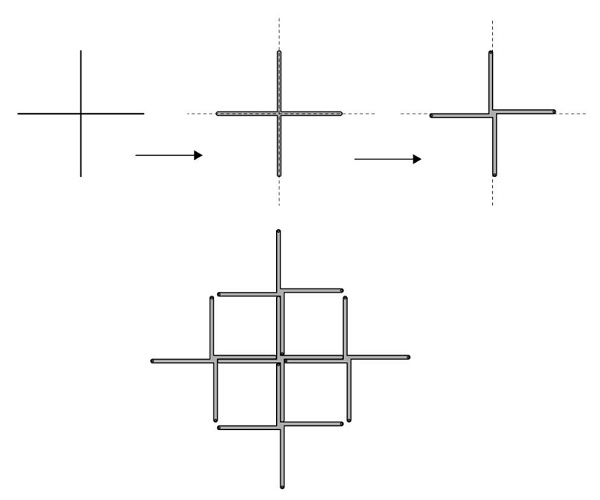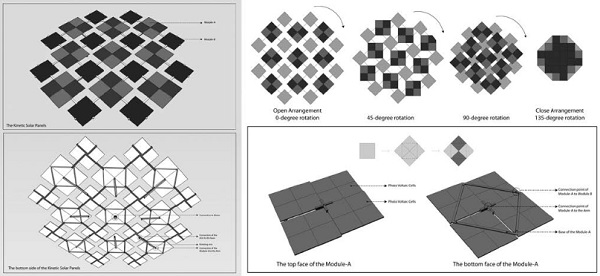Kinetic Solar Panels
Kinetic Solar Panels: A Transformative and Expandable Geometric System for Photovoltaic Structures
Shani Sharif, T Russell Gentry, Jeannette Yen, Joseph N Goodman
Georgia Institute of Technology, USA

Fig. 1. Top: Two-dimensional Tessellation Transformations (Clinton, 1971), Bottom: Three-dimensional Polyhedral Transformation (Verheyen, 1989)
This paper focuses on the applications of geometrically transformable and expandable structures with deployed “energy production” mode and retracted “wind shedding” mode to replace the fixed photovoltaic (PV) panels and racking systems currently used in buildings rooftop installations.
The significance of this expandable geometric system relies on its embedded motion grammar, i.e. rotation and translation transformations, in the system.
The research draws inspiration from reconfiguration of compound tree leaves in nature, and addresses issues of redesign and modeling challenges that led to digital fabrication of the prototype.

Fig. 2. Motion study of the tessellation transformation with square-shape main modules
Photovoltaic systems have proved to be a successful and affordable method of energy production in building and urban scale when implemented in architecture.
PV panels can integrated into roof and façade of new or existing buildings to generate entire or part of the required residential electrical energy (Guiavarch and Peuportier, 2006).

Fig. 3. Cross-shape connecting module
However, the installation of PV panels is typically an elaborate and time consuming task in which the panels are ballasted or attached to over-sized rigid structures to withstand the possible damage due to wind pressure in severe weather conditions (Goodman et al. 2012).
Moreover, conventional solar panels are typically oriented in a fixed direction, calculated to optimize the solar energy collection. Recent research has examined new three-dimensional arrangements for PV panels to increase the energy gain (Bernardi et al., 2012).

Fig. 4. Kinetic solar panels with two overlapped layers
This project departs from current practice of rigid, fixed direction PV mounting and takes cues from nature, which deploys different strategies for similar problems such as folding or collapsing in plant leaves to increase sun gain and protection from the wind.
Studying these methods evolved by natural systems offers design solutions, which have been tested and improved over a long time period in nature.
Specifically, for the current research, study of plant leaves becomes the focus, as plants are dependent on photosynthesis for energy production, a system that requires solar energy (Goodman et al. 2012).

Fig. 5. Final model of the kinetic solar panels
Drawing inspiration from natural system such as trees with compound leaves and looking into their novel wind resistance methods like reconfiguration of the leaflets results in proposing new structures for redesign of solar panel systems.
The kinetic and transformative solar panel tessellations offer new applications in spatial optimization by addressing how transformable objects can dynamically occupy predefined physical space.
In addition, as described by Fox and Kemp: “One of the main benefits of an active sustainable system is that it can intelligently combine the resources of a number of systems so that when working together, the individual elements or systems achieve more than the sum of their parts.” (Fox and Kemp, 2009)




























Comments